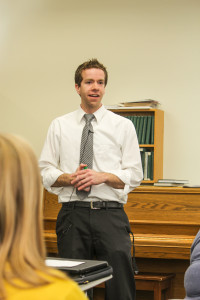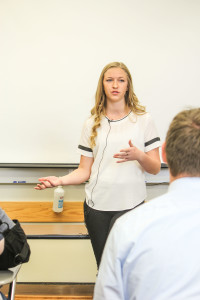Experience Speech
General Purpose: The intent of this speech is to give you a brief initial exposure to speaking in front of an audience while learning to tell personal stories to make a point. Human-interest stories will always be an asset to a speaker. From personal experience in an audience, you know how well they work. Personal experiences will almost always pass the KEY test. (Knowledge, Enthusiasm, Your Audience). Think about it. You are THE expert on YOU. You would share stories that taught you life lessons or are vivid memories. Obviously this is something you have feeling for. Finally, your personal experiences are almost always at least something an audience will have interest in. Your stories and lessons can be useful, entertaining, and moving. The speech should be delivered with great eye contact – this is your story, tell it with ownership.

Dale Carnegie’s advice on how to share personal experiences and stories effectively is the best advice I have read. I am impressed when I see it in action. I highly recommend any of his works, especially How to Win Friends and Influence People and The Quick and Easy Way to Effective Speaking. He gives down-to-earth, real world principles which will be useful for you. Our experience speeches are based on a pattern he recommended.
Length: 3 to 4 minutes. You have to have a minimum of three minutes to get paid anything. You will practice this speech several times in conversation with others. Also practice a few times with a timer so you get a feel of how long three minutes is.
Presentation Practice Center: It is required that you go into the Presentation Practice Center to practice your speech. It will be one-third of your grade.
Speech Structure: The speech has three elements, but there isn’t the rigid structure that you will find in a formal speech. Don’t worry. You’re just telling a story, and doing it in an effective way.
- Experience – You start by getting us right into the story, often with a catchy attention-getting statement. Answer the essential questions, use details and action words. Make that memory as real as you can. This will take up the bulk of your time.
- Lesson – Tell us the life lesson that your experience taught you. Going back to Mr. Carnegie’s advice here: Put it in as few words as possible. I.e. “My point is ‘no success in life can compensate for failure in the home’”; “My point is going without a seatbelt is a luxury no one can afford,”; “Buckle your seatbelts today”. Do not make the audience do ANY work to figure out exactly what your point is. Be clear. Be concise.
- Benefit – * * If your point was a call to action like, “Enroll in a CPR course today,” then the benefit is a concise statement of what your listeners can expect if they apply your lesson. For example, “You will be prepared to save a life tomorrow”.
- Turn In: An outline of your speech is due by MIDNIGHT on the day you present. Submit your outline on the assignment submission page on Canvas.

“I can truthfully say that I have never heard a boring talk when the speaker related what life had taught him, no matter how slight or trivial the lesson may have been.” Dale Carnegie.
*** These ideas are a summary of a few principles in Dale Carnegie and Associates Inc. (1989). The Dale Carnegie Course In Effective Speaking and Human Relations Course Guide. Garden City, New York: DC and Associates Inc. and Carnegie, Dale. (1985). The Quick and Easy Way to Effective Speaking. Garden City, New York: Dale Carnegie and Associates, Inc..
